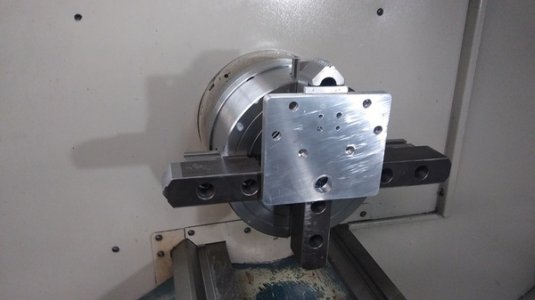- Joined
- Dec 22, 2015
- Messages
- 561
My new King 1236ML (Grizzly G4003) came with 3 and 4 jaw chucks. I recently checked the TIR on the 3 jaw and found it was around 0.011" at 18" from the jaw face, using a piece of 0.75" cold roll steel. So I got out the air die grinding setup and ground the 3 jaw. I just spun it at the highest speed and took very light cuts until each of the teeth had been touched. Now the TIR is less than 0.002" at 16" from the jaw face. Far more accurate than my abilities need.
Now I need to use the 4 jaw so I cleaned all the gunk off and mounted it. Check the TIR and it is about 0.010" at 12" from the face. I checked the runout on the face and the outside diameter of the 4 jaw and it is less than 0.001". So now I want to grind the jaws but not sure how to go about it. I know this subject has been discussed before but my search produced nada. I'm thinking I would use the same grinder setup and hit each jaw separately, ie have one jaw slightly more closed than the others and do this until each tooth has been touched by the grinder. Then repeat with the other jaws. Does this make sense or not?
I'm also concerned about turning the 4 jaw at 1500 RPM (the max speed according to the lathe decals) since the chuck is stamped max 1350 RPM. The next fastest speed is 1000 RPM.
What say the experts?
Now I need to use the 4 jaw so I cleaned all the gunk off and mounted it. Check the TIR and it is about 0.010" at 12" from the face. I checked the runout on the face and the outside diameter of the 4 jaw and it is less than 0.001". So now I want to grind the jaws but not sure how to go about it. I know this subject has been discussed before but my search produced nada. I'm thinking I would use the same grinder setup and hit each jaw separately, ie have one jaw slightly more closed than the others and do this until each tooth has been touched by the grinder. Then repeat with the other jaws. Does this make sense or not?
I'm also concerned about turning the 4 jaw at 1500 RPM (the max speed according to the lathe decals) since the chuck is stamped max 1350 RPM. The next fastest speed is 1000 RPM.
What say the experts?


